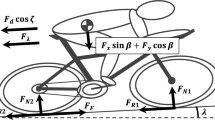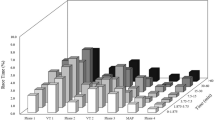Abstract
Road cycling performance is dependent on race tactics and pacing strategy. To optimise the pacing strategy for any race performed with no drafting, a numerical model was introduced, one that solves equations of motion while minimising the finishing time by varying the power output along the course. The power output was constrained by two different hydraulic models: the simpler critical power model for intermittent exercise (CPIE) and the more sophisticated Margaria–Morton model (M–M). These were compared with a constant power strategy (CPS). The simulation of the three different models was carried out on a fictional 75 kg cyclist, riding a 2,000 m course. This resulted in finishing times of 162.4, 155.8 and 159.3 s and speed variances of 0.58, 0.26 and 0.29 % for the CPS, CPIE and M–M simulations, respectively. Furthermore, the average power output was 469.7, 469.7 and 469.1 W for the CPS, CPIE and M–M simulations, respectively. The M–M model takes more physiological phenomena into consideration compared to the CPIE model and, therefore, contributes to an optimised pacing strategy that is more realistic. Therefore, the M–M model might be more suitable for future studies on optimal pacing strategy, despite the relatively slower finishing time.





Similar content being viewed by others
References
Kennelly AE (1906) An approximate law of fatigue in the speeds of racing animals. Proc Am Acad Arts Sci 42:275–331
Keller JB (1974) Optimal velocity in a race. Am Math Mon 81:474–480. doi:10.2307/2318584
Ariyoshi M, Yamaji K, Shephard RJ (1979) Influence of running pace upon performance: effects upon treadmill endurance time and oxygen cost. Eur J Appl Physiol Occup Physiol 41:83–91
Billat V, Hamard L, Koralsztein JP, Morton RH (2009) Differential modeling of anaerobic and aerobic metabolism in the 800-m and 1,500-m run. J Appl Physiol 107:478–487. doi:10.1152/japplphysiol.91296.2008
Swain DP (1997) A model for optimizing cycling performance by varying power on hills and in wind. Med Sci Sport Exer 29:1104–1108. doi:10.1097/00005768-199708000-00017
Atkinson G, Brunskill A (2000) Pacing strategies during a cycling time trial with simulated headwinds and tailwinds. Ergonomics 43:1449–1460. doi:10.1080/001401300750003899
de Koning JJ, Bobbert MF, Foster C (1999) Determination of optimal pacing strategy in track cycling with an energy flow model. J Sci Med Sport 2:266–277. doi:10.1016/S1440-2440(99)80178-9
Gordon S (2005) Optimising distribution of power during a cycling time trial. Sports Eng 8:81–90. doi:10.1007/bf02844006
Cangley P, Passfield L, Carter H, Bailey M (2011) The effect of variable gradients on pacing in cycling time-trials. Int J Sports Med 32:132–136. doi:10.1055/s-0030-1268440
Dahmen T (2012) Optimization of pacing strategies for cycling time trials using a smooth 6-parameter endurance model. In: Pre-olympic congress on sports science and computer science in sport (IACSS2012). IACSS Press, Liverpool
Dahmen T, Saupe D, Wolf S (2012) Applications of mathematical models of road cycling. In: Vienna international conference on mathematical modelling (MATHMOD), Vienna, Austria
Morton RH (2006) The critical power and related whole-body bioenergetic models. Eur J Appl Physiol 96:339–354. doi:10.1007/s00421-005-0088-2
Dahmen T (2012) Computing a field of optimal pacing strategies for cycling time trials. In: Symposium der dvs-Sektion Sportinformatik, Konstanz, Germany
Morton RH (1986) A three component model of human bioenergetics. J Math Biol 24:451–466
Morton RH (1990) Modelling human power and endurance. J Math Biol 28:49–64
Morton RH, Billat LV (2004) The critical power model for intermittent exercise. Eur J Appl Physiol 91:303–307. doi:10.1007/s00421-003-0987-z
Meriam JL, Kraige LG (2013) Engineering mechanics dynamics SI version, 7th edn. Wiley, Singapore
Martin JC, Milliken DL, Cobb JE, McFadden KL, Coggan AR (1998) Validation of a mathematical model for road cycling power. J Appl Biomech 14:276–291
Meriam JL, Kraige LG (2013) Engineering mechanics statics SI version, 7th edn. Wiley, Singapore
Dahn K, Mai L, Poland J, Jenkins C (1991) Frictional resistance in bicycle wheel bearings. Cycl Sci 3:28–32
Sundström D, Carlsson P, Ståhl F, Tinnsten M (2013) Numerical optimization of pacing strategy in cross-country skiing. Struct Multidisc Optim 47:943–950. doi:10.1007/s00158-012-0856-7
Svanberg K (1987) The method of moving asymptotes: a new method for structural optimization. Int J Numer Meth Eng 24:359–373. doi:10.1002/nme.1620240207
Svanberg K (1993) The method of moving asymptotes (MMA) with some extensions. Optim Large Struct Syst 1(231):555–566
Sundström D, Carlsson P, Tinnsten M (2013) On optimization of pacing strategy in road cycling. In: 6th Asia-Pacific congress on sports technology (APCST), Elsevier, Hong Kong
Minetti AE (2011) Bioenergetics and biomechanics of cycling: the role of ‘internal work’. Eur J Appl Physiol 111:323–329. doi:10.1007/s00421-010-1434-6
McArdle WD, Katch FI, Katch VL (2010) Exercise physiology: nutrition, energy, and human performance, 7th edn. Lippincott Williams and Wilkins, Baltimore
Coyle EF, Sidossis LS, Horowitz JF, Beltz JD (1992) Cycling efficiency is related to the percentage of type I muscle fibers. Med Sci Sport Exer 24:782–788
Lucia A, Juan AFS, Montilla M, Canete S, Santalla A, Earnest C, Perez M (2004) In professional road cyclists, low pedaling cadences are less efficient. Med Sci Sport Exer 36:1048–1054. doi:10.1249/01.Mss.0000128249.10305.8a
Del Coso J, Mora-Rodriguez R (2006) Validity of cycling peak power as measured by a short-sprint test versus the Wingate anaerobic test. Appl Physiol Nutr Metab: Physiologie Appliquee Nutrition Et Metabolisme 31:186–189. doi:10.1139/H05-026
Brickley G, Dekerle J, Hammond AJ, Pringle J, Carter H (2007) Assessment of maximal aerobic power and critical power in a single 90-s isokinetic all-out cycling test. Int J Sports Med 28:414–419. doi:10.1055/s-2006-924513
Margaria R, Margaria R (1976) Biomechanics and energetics of muscular exercise. Clarendon Press, Oxford
Heil DP (2001) Body mass scaling of projected frontal area in competitive cyclists. Eur J Appl Physiol 85:358–366
Heil DP (2002) Body mass scaling of frontal area in competitive cyclists not using aero-handlebars. Eur J Appl Physiol 87:520–528. doi:10.1007/s00421-002-0662-9
Grappe F, Candau R, Barbier B, Hoffman MD, Belli A, Rouillon JD (1999) Influence of tyre pressure and vertical load on coefficient of rolling resistance and simulated cycling performance. Ergonomics 42:1361–1371. doi:10.1080/001401399185009
Jones AM, Wilkerson DP, Vanhatalo A, Burnley M (2008) Influence of pacing strategy on O2 uptake and exercise tolerance. Scand J Med Sci Sports 18:615–626. doi:10.1111/j.1600-0838.2007.00725.x
Hill DW, Ferguson CS (1999) A physiological description of critical velocity. Eur J Appl Physiol Occup Physiol 79:290–293. doi:10.1007/s004210050509
Morton RH (2009) A new modelling approach demonstrating the inability to make up for lost time in endurance running events. Ima J Manag Math 20:109–120. doi:10.1093/imaman/dpn022
Morton RH (1996) A 3-parameter critical power model. Ergonomics 39:611–619. doi:10.1080/00140139608964484
St Clair Gibson A, Noakes TD (2004) Evidence for complex system integration and dynamic neural regulation of skeletal muscle recruitment during exercise in humans. Br J Sports Med 38:797–806. doi:10.1136/bjsm.2003.009852
Noakes TD, Gibson AS, Lambert EV (2005) From catastrophe to complexity: a novel model of integrative central neural regulation of effort and fatigue during exercise in humans: summary and conclusions. Brit J Sport Med 39:120–124. doi:10.1136/bjsm.2003.010330
Skiba PF, Chidnok W, Vanhatalo A, Jones AM (2012) Modeling the expenditure and reconstitution of work capacity above critical power. Med Sci Sports Exerc 44:1526–1532. doi:10.1249/MSS.0b013e3182517a80
Acknowledgments
This work was supported by the European Regional Development Fund of the European Union.
Conflict of interest
The authors declare that they have no conflict of interest.
Author information
Authors and Affiliations
Corresponding author
Rights and permissions
About this article
Cite this article
Sundström, D., Carlsson, P. & Tinnsten, M. Comparing bioenergetic models for the optimisation of pacing strategy in road cycling. Sports Eng 17, 207–215 (2014). https://doi.org/10.1007/s12283-014-0156-0
Published:
Issue Date:
DOI: https://doi.org/10.1007/s12283-014-0156-0




